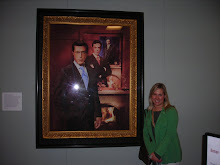But privacy online is a concern of mine, as it is for most of us in this day and age. I shred my bills, I’m conscious of what photos I’m posting, and I make sure not to accept friend requests from those mean kids from high school who probably just want to see if I’ve gotten fat since then. But even so, privacy goes beyond all of that; and efforts to keep our information private will always be one step behind those who are trying to steal it.
One of the things we most love about the internet, its accessibility, is also something that makes it a serious threat to us as individuals. Items that we put on social networking sites seem like they’re just being shared with the friends of our choosing, but these things are instantly entered into the public domain. That means anyone who may be looking for it, can see it.

Right now, this is a huge problem largely because we’re not yet used to it. The next generation of children to grow up with the internet and social networking as a more prevalent part of their lives from the start and will be able to cope better. When privacy issues are the norm, they won’t be as likely to make mistakes like posting a cell phone number on someone’s blog or forwarding a boyfriend or girlfriend an inappropriate picture.
For the rest of us, though, we need to adjust. According to Alma Whitten, Privacy Engineer at Google, this means adjusting our settings. Privacy online is all but dead, Whitten says, but users need to be proactive about protecting their information instead of just hoping no one sees it and later lamenting when they do. Google, for instance, offers several tools meant to limit how much information about a Google user (i.e. gmail) is released in a search.
Facebook has settings options as well that help to protect their users. Sarah Perez of the New York Times highlights “The 3 Facebook Settings that Every User Should Check Now” to keep their information private. Perez notes in her article that this past December, Facebook made a “series of bold and controversial changes regarding the nature of its users’ privacy settings.” The move was discussed by many news outlets, but only after the changes were made. Facebook made these drastic modifications—which basically reset everyone’s privacy settings to “viewable by everyone”—relatively quickly and quietly, as to hopefully go unnoticed. And, for many, the changes did go and are still unnoticed. Although those users might be surprised at what others are able to see about them that they didn’t intend.
So if we’re able to just click our web settings into the right place to stay protected, then why are there still so many problems with privacy issues? Aside from the fact that many users aren’t even aware that the site they’re using has changeable settings, there are some things that we can’t adjust. Sometimes it’s not about what you’re telling people on the internet, it’s about what the internet already knows about you.
Let me illustrate this point with an example. Have you ever Googled a topic; let’s say for instance Betsy Johnson purses. You click around the links that your search yields, then close out and move on to something else in your day. Hours, maybe days later, you’re at a completely different site and the ads in the margins are advertising Betsy Johnson purses. Wow! What are the odds of that? If you ask Steve Lohr of the New York Times, the odds are more than good. They’re guaranteed.
That’s because search engines and advertisers work hand in hand to make notes about you. Anything from what you punch into your search engine to who you associate with on social networking sites. After awhile, patterns develop—things you shop for often, college alumni that you associate with, political party tende
 ncies, movie stars you hate—it all builds a kind of profile about you. That profile, or “social signature,” as researchers dub it, is how advertisers target your specific interests.
ncies, movie stars you hate—it all builds a kind of profile about you. That profile, or “social signature,” as researchers dub it, is how advertisers target your specific interests.Lohr says that when the patterns in your social signature are analyzed, it could lead to more drastic privacy violations, like figuring out a user’s social security number. But for now, that’s only a “potential risk.” Even so, the Federal Trade Commission and Congress are already taking steps to, as Lohr says “tighten industry requirements” as far as tracking methods are concerned, to protect people on the web. If and when those regulations are implemented, whether they’ll work is anybody’s guess.
But, on the other hand, as much as we should fear a lack of security on the internet, should we also fear too much of it? After all, the internet is a domain for free speech, and regulations on free speech generally lead into very sticky territory.
Take, for example, the recent conviction of three Google employees in Milan, Italy. According to the judge, the three were guilty of privacy violation because their employer, Google, hosted a video of an autistic teen being bullied.
The judge’s reasoning for the verdict was that Google hosting the video would have meant a profit for the site, as they would’ve gained revenue from ads sold on the page the video was posted.
The judge mentioned that this trail should be considered an “important signal” that web masters could and should be held criminally responsible for what their sites host.
At first glance, it might be considered a good thing that this judge is the first to, at the very least, make web masters concerned about the content of their sites. And in Italy, such a statute may be upheld in the future. But in the U.S., we’ve run into this situation before, and it does not end well for the prosecution.
In 1997, the U.S. Court of Appeals heard the case of Zeran v. AOL, after Kenneth Zeran was bombarded by phone calls from across the country after an unknown internet user posed advertisements in an AOL chat room for a t-shirt company called “Naughty Oklahoma
 T-Shirts.” The products of the company featured offensive slogans concerning the Oklahoma City bombings, which had occurred just weeks prior, and people who saw the ads were of course outraged.
T-Shirts.” The products of the company featured offensive slogans concerning the Oklahoma City bombings, which had occurred just weeks prior, and people who saw the ads were of course outraged.The phone calls got so bad (nearly one every two minutes; many were death threats) that Zeran’s daily life was drastically altered and he sued AOL for damages. In the end, the court sided with AOL, citing two major issues: Freedom of the Press (as the internet is likely the future of the press) and also the fact that the web is just too darn big. By that, I mean that with the internet as vast as it is and growing by the day, for online providers to be held responsible for overseeing everything they host is not only unconstitutional but impossible.
The judges in the Zeran case didn’t want to set a dangerous precedent where providers would be held to impracticable responsibility standards that would force them to shut down and hinder the growth of internet technology. The ruling in Milan last week, however, has the potential to do just that.
So, in other words, when it comes to privacy online, we’re walking on egg shells. Because, yes, we do want a certain level of security when we’re on the internet, but we also want to have full access to the free exchange of information that the web gives us. And when cyber crime does happen, we of course want to point our fingers at someone to blame, but on the other hand we want to keep regulation out of our internet usage, so responsibility comes at a price.
Yikes, talk about a rock and a hard place. It seems like the best thing to do, for now, would be to heed Ms. Whitten’s advice and do what we can on a personal level to protect ourselves. Jon Kleinberg, a computer science professor at Cornell University, agrees. He says, “When you’re doing stuff online, you should behave as if you’re doing it in public — because increasingly, it is.”
Internet Privacy photo by Barry D, Licensed by Creative Commons as Attribution 2.0 Generic
















